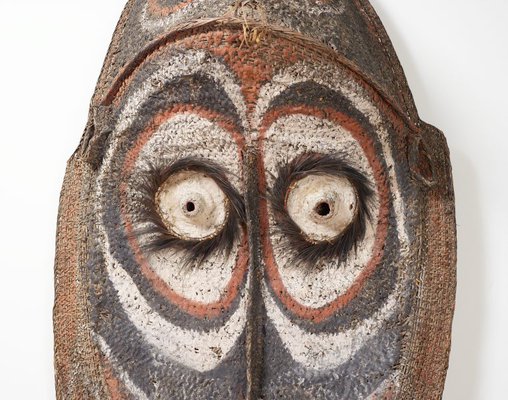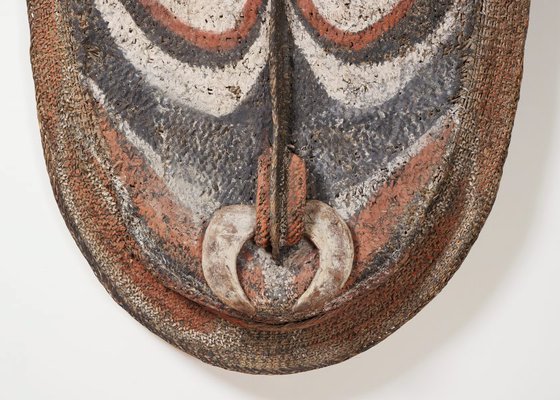Title
Gable mask from ceremonial house facade
mid 20th century
Artist




-
Details
- Other Title
- Gable mask
- Place where the work was made
-
Blackwater River
→
East Sepik Province
→
Papua New Guinea
- Cultural origin
- probably Kapriman people
- Date
- mid 20th century
- Media category
- Ceremonial object
- Materials used
- woven rattan cane, natural pigments, cassowary feathers (Casuarius), wood
- Dimensions
- 181.5 x 102.0 x 51.0 cm
- Credit
- Purchased 1964
- Location
- Not on display
- Accession number
- IA13.1964
- Copyright
- © Kapriman people, under the endorsement of the Pacific Islands Museums Association's (PIMA) Code of Ethics
- Artist information
-
attrib. Kapriman people
Works in the collection
- Share
-
-
About
Across the Sepik, spectacular ceremonial houses are found in every village. They are known as 'geko', 'ŋgaigo' or 'ngeko' in Iatmul, and 'haus tambaran' in Pidgin. In the Middle Sepik, the 'geko' embodies the paramount female ancestor whose enormous face appears on the gable and whose name is given to the house. Clans descending from a common ancestor build the 'geko', where cult objects are stored. Only men who are initiated are permitted inside the 'geko' and, during ritual ceremonies, the house becomes 'hot', indicating the presence of spirits.
Gable masks are either carved from wood or woven using split rattan cane and are hung high above the entrance of the 'geko'. Woven examples such as this feature prominent foreheads, separately attached ears and broad, open mouths filled with fine teeth.
[entry from Exhibition Guide for 'Melanesian art: redux', 2018, cat no 15]
-
Exhibition history
Shown in 3 exhibitions
Melanesian Art, Art Gallery of New South Wales, Sydney, 20 Apr 1966–22 May 1966
Aboriginal and Melanesian art, Art Gallery of New South Wales, Sydney, 19 Oct 1974 -
Melanesian art: redux, Art Gallery of New South Wales, Sydney, 17 Nov 2018–17 Feb 2019
-
Bibliography
Referenced in 7 publications
-
Art Gallery of New South Wales, 1964 Acquisitions, Sydney, 1964, 62. cat.no. 112
-
Peter Laverty (Editor), Art Gallery of New South Wales Quarterly (vol. 13, no. 4), Sydney, Jul 1972, 697 (illus.). "The primitive art area is temporarily situated on the first floor. Exhibits are from the Sepik River, New Guinea, along with a grave-symbol figure from New Hebrides, in the left foreground". The 'Gable mask' is seen on the wall, together with other works collected by Tuckson in the 1960s and early 1970s.
-
JA Tuckson, Art Gallery of New South Wales Quarterly, 'Some Sepik River art from the collection', pg. 666-679, Sydney, Apr 1972, 668, 671, 676 (illus.). plate no. 10
-
Tony Tuckson, Aboriginal and Melanesian art, Sydney, 1973, 45. cat.no. 83
-
Tony Tuckson, Melanesian art, Sydney, 1966, front cover (illus.), 12. cat.no. 118
-
Tony Tuckson, Art and Australia, 'Primitive art collection', pg. 76-79, Sydney, Jul 1972, 79 (illus.). Image of work in the 'Primitive Gallery' at the AGNSW in 1972, with other works from the collection.
-
Editor Unknown (Editor), Art Gallery of New South Wales Quarterly, Sydney, Apr 1965, 232 (illus.).
-
